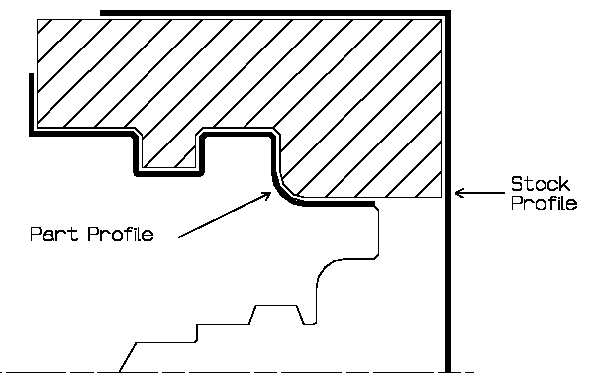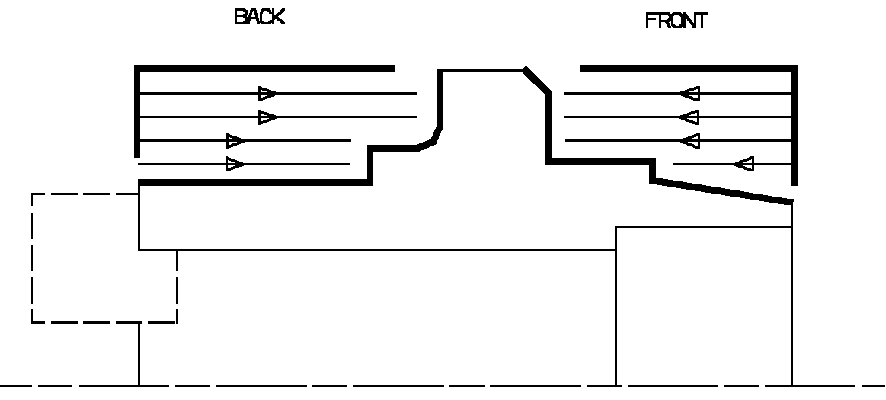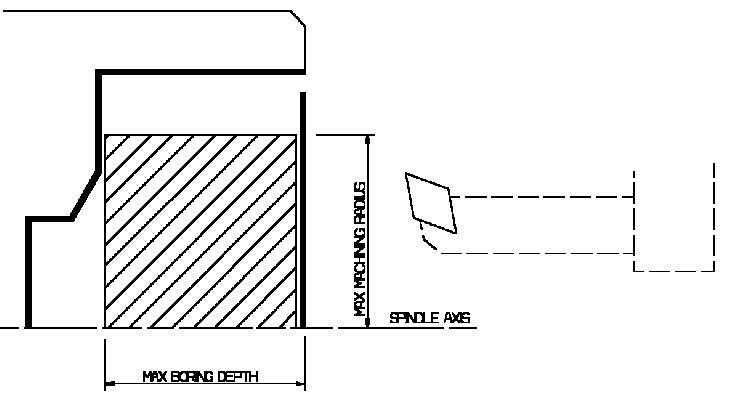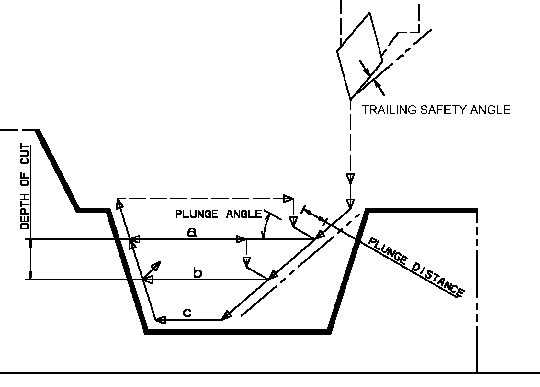
The information in this section will help you create and edit Rough Turning operations in your manufacturing program.
The Rough Turning operation allows you to specify:
The following topics are dealt with in the paragraphs below:
The following tooling may be used:
Note that the following attributes may influence machining (they are located on the Insert-holder's Technology tab):
These attributes take tooling accessibility into account and may reduce the
machined area.
However, you can use the Insert-Holder Constraints option on the
operation editor to either ignore or apply these tooling attributes. You can
replay the operation to verify the influence of these attributes on the
generated tool path.
Note that the Insert-Holder Constraints setting does not influence the Leading and Trailing Safety Angles defined in the operation editor.
Part and Stock profiles are required. They can be specified as follows:
Multiple areas are not managed. If a profile with multi-domains is selected manually or by means of the automatic stock selection capability, only a single area is taken into account for machining.
The End Limit option allows you to specify a point, line, curve or face to relimit or extrapolate the selected part profile. If a face is specified, the end element is the intersection of the face and the working plane. The position of the end of machining is defined with respect to this element by one of the following settings: None / In / On / Out.
Relimiting the area to machine by means of limit elements
If you specify a point, it is projected onto the part profile.
A line through the projected point parallel to the radial axis delimits the
area to machine.
If you specify a line, its intersection with the part profile is calculated (if
necessary, the line is extrapolated).
A line through the intersection point parallel to the radial axis delimits the
area to machine.
If you specify a curve, its intersection with the part profile is calculated
(if necessary, the curve is extrapolated using the tangent at the curve
extremity).
A line through the intersection point parallel to the radial axis delimits the
area to machine.
The following Orientations are proposed: Internal, External and Frontal (for Face and Parallel Contour Rough Turning only).
The selected Orientation defines the type of geometric relimitation to be done between the stock and part geometry in order to determine the area to machine. Selected part and stock profiles do not need to be joined (see the following figures).


Frontal machining is proposed for face Rough Turning. In that case, the minimum and maximum diameters of the area to machine are determined by the stock profile dimensions.
For example, in the following figure the area to machine is relimited by the spindle axis because the stock profile is also relimited by the spindle axis.

Offsets can be positive or negative with any absolute value. The global offset applied to the part profile is the resulting value of the normal, axial and radial offsets.
The following machining Locations are proposed:

Orientation and Location settings determine the way the program closes the area to machine using radial, axial, axial-radial or radial-axial relimitation.
The following options allow you to restrict the area to machine that is pre-defined by the stock and part. You may want to restrict this area due to the physical characteristics of the tool and the type of machining to be done.
Maximum Machining Radius (for internal machining)

Note that Max Boring Depth is defined on the tool.
Axial Limit for Chuck Jaws (for external or frontal machining): Offset defined from the machining axis system.
The following options are proposed for recess machining:
- Plunge Distance and Plunge Angle (for longitudinal and face Rough Turning)
Define the plunge vector before each new pass with respect to the cutting direction.

In the figure above the tool motion is as follows:
Note that Trailing angle is defined on the tool.
Machining in Parallel Contour Rough Turning is done by means of successive
offsets of the toolpath: the offset depends on the axial and radial depth of
cut values.
The following recommendations describe how to set the axial and radial depth of
cuts to ensure a collision free toolpath.
Parallel contour principle:
The parallel contours of the toolpath are obtained by first shifting the last
pass then shifting each successive pass depending on the axial and radial depth
of cut values.
Then the passes are relimited taking into account the stock definition.
Correct combination of axial and radial depth of cuts
Compared with the left and right angles on the insert, the axial and radial
depth of cut values define a shift direction that must be compatible with the
insert.
The shift direction must be inside the limit angles defined on the tool insert otherwise a collision may occur. In collision cases, the collision is on the first pass, not on the last passes of the toolpath.
Example of a correct combination
Example of an incorrect combination (right of tool)
The parallel contour toolpath is in collision because the shift does not respect the tool insert angle on the right side.
These options allow penetration into the workpiece at a reduced feedrate in order to prevent tool damage. Once the attack distance has been run through, the tool moves at machining feedrate.
Lead-in distance takes the stock profile and stock clearance into account. The tool is in RAPID mode before this distance.
If no lead-in angle is requested, the lead-in path is normal to the cutting direction.
For Longitudinal and Face Rough Turning the lead-in angle can be applied as follows:
- no angle applied to lead-in path
- lead-in angle applied to each path
- lead-in angle applied to last path only.
For Parallel Contour Rough Turning, the Lead-in angle is applied to each path.
For Longitudinal or Face Rough Turning, lift-off occurs:
For Parallel Contour Rough Turning, lift-off occurs when the end of the pass has already been machined by a previous pass.
then you can give a Machining Speed value.
Feedrates in units per minute are also available
for air cutting such as macro motions and path transitions.
Note that RAPID feedrate can be replaced by Air Cutting feedrate in tool
trajectories (except in macros) by selecting the checkbox in the Feed and
Speeds tab page
![]() .
.
Dwell setting indicates whether the tool dwell at the end of each path is to be set in seconds or a number of spindle revolutions.
Please note that decimal values can be used for the number of revolutions. For example, when machining big parts that have a large volume, it can be useful to specify a dwell using a value of less than one revolution (0.25, for example).
You can select a tool compensation number corresponding to the desired tool output point. Note that the usable compensation numbers are defined on the tool assembly linked to the machining operation. If you do not select a tool compensation number, the output point corresponding to type P9 will be used by default.
The following
Approach and Retract macro modes are proposed:
Direct, Axial-radial, Radial-axial, and Build by user.
The selected macro type (Approach or Retract)
defines the tool motion before or after machining.
Various feedrates are available for the approach and retract motions (RAPID, lead-in, lift-off, and so on).
Linking macros, which comprise retract and approach motion can also be used on Rough Turning operations. Approach and retract motions of linking macros are interruptible. It can be useful to interrupt an operation when the foreseeable lifetime of the insert is not long enough to complete the machining.
See Define Macros on a Turning Operation for more information.